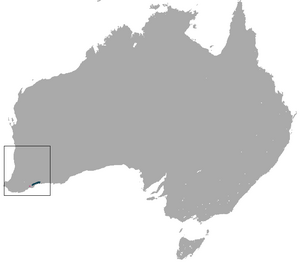Dibbler facts for kids
Quick facts for kids Dibbler |
|
|---|---|
 |
|
| Conservation status | |
| Scientific classification | |
| Genus: |
Parantechinus
|
| Species: |
apicalis
|
 |
|
| Dibbler range (blue — native, pink — reintroduced) |
|
The dibbler (Parantechinus apicalis) is a small, furry animal from Western Australia. It's a type of marsupial, which means it carries its babies in a pouch. Dibblers are quite rare and are an endangered species.
These little creatures live in the southwest part of mainland Western Australia. They also live on some islands off the coast. The dibbler is the only member of its group, called Parantechinus. It is a nocturnal animal, meaning it is active mostly at night.
Contents
What Does a Dibbler Look Like?
A dibbler is about 10 to 16 centimeters (4 to 6 inches) long. Its tail adds another 7.5 to 12 centimeters (3 to 5 inches). It weighs between 40 and 125 grams (1.4 to 4.4 ounces). That's about as much as a small apple!
You can spot a dibbler by its white rings around its eyes. Its fur is gray-brown with tiny white speckles. It also has a short, pointy tail. Dibblers have strong jaws and big canine teeth. These teeth help them catch their food.
What Do Dibblers Eat?
Dibblers are carnivores, which means they eat meat. They hunt small animals like mice, birds, and lizards. They also enjoy eating insects and other tiny creatures without backbones.
Sometimes, they climb trees to find food. They can eat nectar from flowers and berries too. This makes them partly tree-dwelling, or "semi-arboreal."
Where Do Dibblers Live?
Dibblers are found in southwestern Western Australia. You can find them on islands like Boullanger Island and Whitlock Island. They have also been moved to Escape Island and Gunton Island.
On the mainland, they live in the Fitzgerald River National Park. They have also been reintroduced to the Peniup Proposed Nature Reserve. Recently, some dibblers were released on Dirk Hartog Island. This is part of a special project to bring them back to areas where they once lived.
Dibblers like to live in areas that haven't been burned by fires. They prefer places with lots of thick leaf litter on the ground. They also like sandy soils, especially near the coast.
Understanding Dibbler Names
How Scientists Classify Dibblers
The dibbler is the only animal in its scientific group, called a genus. This genus is named Parantechinus. The name means "like an antechinus," which is another type of marsupial. The word apicalis means "pointed," probably referring to its tail.
A scientist named John Edward Gray first described the dibbler in 1842. He put it in a group called Phascogale. Later, in 1947, George Henry Hamilton Tate created the genus Parantechinus just for the dibbler.
Why is it Called a Dibbler?
The name 'dibbler' is the official and most common name for this animal. It comes from the Noongar language, spoken by Aboriginal people in the King George Sound region of Western Australia.
Some older names for the dibbler include 'freckled antechinus' or 'speckled marsupial mouse'. You might also hear it called the "southern dibbler." This is to tell it apart from another animal called the "northern dibbler" or "sandstone dibbler," which lives in the Northern Territory.
Why Are Dibblers Endangered?
In the early 1800s, dibblers lived all over Western Australia. But by 1884, people thought they were completely gone. Luckily, some were found again in 1967 at Cheyne Beach.
Today, dibblers are an endangered species. This means they are at risk of disappearing forever. Their biggest threats are:
- Habitat loss: Their homes are destroyed by land clearing and plant diseases.
- Predators: Wild foxes and cats hunt and kill them.
Good news! The Perth Zoo in Western Australia has a special program. They work with the Department of Environment and Conservation to help dibblers. They breed dibblers in the zoo and then release them into the wild. This helps more dibblers survive and grow their numbers.
See also
 In Spanish: Díbler meridional para niños
In Spanish: Díbler meridional para niños


